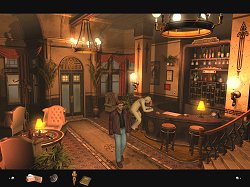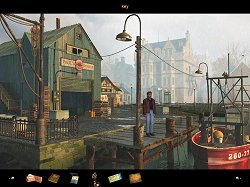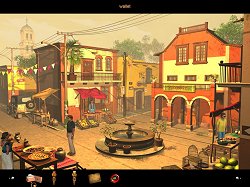|
NiBiRu: Age of Secrets
 Nibiru: Age of Secrets comes to us from the team that created The Black Mirror, and the signature use of subdued lighting is back again. This gives the outdoor locations an evocative twilight or Autumnal feel, broodily suggesting that nightfall or Winter isn't too far away. And, of course, there's the rain as well, yet another indicator of mood - faintly depressing and, perhaps, a portent of darker things to come. This atmosphere worked just fine in The Black Mirror given the dark nature and setting of that tale. Though the 'feel' is still good, it's somewhat less effective in Nibiru, which is an altogether different story, not so dark, and with more varied locations taking in Bohemia, Paris, and Mexico. Nibiru: Age of Secrets comes to us from the team that created The Black Mirror, and the signature use of subdued lighting is back again. This gives the outdoor locations an evocative twilight or Autumnal feel, broodily suggesting that nightfall or Winter isn't too far away. And, of course, there's the rain as well, yet another indicator of mood - faintly depressing and, perhaps, a portent of darker things to come. This atmosphere worked just fine in The Black Mirror given the dark nature and setting of that tale. Though the 'feel' is still good, it's somewhat less effective in Nibiru, which is an altogether different story, not so dark, and with more varied locations taking in Bohemia, Paris, and Mexico. Though the name Nibiru is associated with the ancient Sumerians and a belief in the existence of a mysterious planet beyond the orbit of Pluto, the game is only remotely linked to this premise through the belief that we have been visited in the past by intelligent beings from that planet. The stronger premise behind Nibiru is, perhaps, a more familiar one if you have seen the movie Raiders of the Lost Ark. The investigation gets tangled up with the Nazis and their interest in the supernatural and, possibly, extra-terrestrial artefacts that they believed could help them conquer the world.
The story opens with your character Martin Holan, a linguistics and archaeology student, despatched to Prague by his uncle to investigate the recent discovery of a World War II tunnel. A simple enough assignment that quickly goes wrong, and Martin soon learns that, whatever secret may be uncovered, someone is prepared to kill for it. Your first task is to meet your uncle's contact in Prague, but she seems to have got tired of waiting for you, or is something more sinister afoot? What follows is an Indiana Jones-style adventure where the investigation of a recent mystery leads to a more ancient one. The game has its light-hearted moments, too, whether it be overcoming a Kafkaesque bureaucracy, dealing with an Inspector Clouseau-type detective, or joining forces with a lazy treasure hunter who wants gold but is not prepared to work for it.
Having recently played Martin Mystere I am struck by the obvious similarities between that game and Nibiru. Both have main characters called Martin who are archaeologists, both involve murder and the theft of secrets, both travel to Mexico and explore ancient sites, and both uncover an ancient mystery there. Still it is clearly coincidental that both games have been released, or at least had a wider distribution, within weeks of each other. Not that I am complaining, I think it's great that more third-person perspective, 'traditional' point and click adventures are being published.
 In Nibiru: Age of Secrets there are plenty of items to pick up and use and some can be combined in your inventory which sits at the bottom of the screen. When you use an item your cursor changes to an icon representing the item, and if you can use it on a hotspot or on another inventory item the icon will flash to let you know you're on the right track. As you might expect there are doors to be unlocked, machinery to be repaired or started, and characters to be helped before they will help you.
Those of you who have played The Black Mirror will be familiar with the Nibiru interface where the cursor turns gold to indicate that there is something to do and remains gold to alert you that there is still more to do at that spot. Only when the cursor turns silver can you safely move on, though sometimes you may need to return to a hotspot after you have done something else to see if more information is forthcoming. Don't forget to both left and right click on the hotspots. The game keeps you focussed by limiting the locations you can explore in any one area, and often you won't be allowed to leave until you have done everything there is to do. Occasionally you will know what to do but won't be allowed to do it until you have carried out all the steps that the game requires. Navigation is easy and, though Martin doesn't run, you can quickly jump to new areas by double clicking on exits.
In addition to the inventory-based puzzles you will also find some logic ones such as the tangram in the Nazi tunnels or the slider and rotating concentric circle puzzles in the Mayan temples. These puzzles inject some variety into Nibiru and, though they demand some patience (how much will depend on you), they slot fairly well into the gameplay. You will also need to learn something of the Mayan numbering system to progress at one point and there are a couple of mild timed sequences. Nothing to worry too much about. If your time runs out you will be instantly returned to the start of the sequence. I even found one crate but I wasn't allowed to push it ... you will know what you need to do when the time comes. In Nibiru: Age of Secrets there are plenty of items to pick up and use and some can be combined in your inventory which sits at the bottom of the screen. When you use an item your cursor changes to an icon representing the item, and if you can use it on a hotspot or on another inventory item the icon will flash to let you know you're on the right track. As you might expect there are doors to be unlocked, machinery to be repaired or started, and characters to be helped before they will help you.
Those of you who have played The Black Mirror will be familiar with the Nibiru interface where the cursor turns gold to indicate that there is something to do and remains gold to alert you that there is still more to do at that spot. Only when the cursor turns silver can you safely move on, though sometimes you may need to return to a hotspot after you have done something else to see if more information is forthcoming. Don't forget to both left and right click on the hotspots. The game keeps you focussed by limiting the locations you can explore in any one area, and often you won't be allowed to leave until you have done everything there is to do. Occasionally you will know what to do but won't be allowed to do it until you have carried out all the steps that the game requires. Navigation is easy and, though Martin doesn't run, you can quickly jump to new areas by double clicking on exits.
In addition to the inventory-based puzzles you will also find some logic ones such as the tangram in the Nazi tunnels or the slider and rotating concentric circle puzzles in the Mayan temples. These puzzles inject some variety into Nibiru and, though they demand some patience (how much will depend on you), they slot fairly well into the gameplay. You will also need to learn something of the Mayan numbering system to progress at one point and there are a couple of mild timed sequences. Nothing to worry too much about. If your time runs out you will be instantly returned to the start of the sequence. I even found one crate but I wasn't allowed to push it ... you will know what you need to do when the time comes.
 The high resolution graphics are excellent, I have already mentioned the atmosphere they create, and I also appreciated the little touches such as a tram appearing in the streets of Prague and lights going on in buildings at night. You may even see a silhouette in a window if you look carefully. The animations too deserve a mention, especially Martin carrying out some actions. Watch out for his busy fingers as he types.
The music adds to the atmosphere as do the ambient sounds like the ticking of a clock, the murmur of unseen traffic at night, creaking floorboards and the wind in an attic. All manner of birds and insects make their presence felt without being seen. The voice acting is generally very good, especially Martin's, though one or two accents are dodgy. Conversations are mainly handled by the game, simply talk and Martin will do the rest. Occasionally during conversation an icon of an item or character will appear at the bottom of the screen and you can click on it to ask about it.
Nibiru: Age of Secrets comes on two CDs, installs completely to the hard drive and plays without the need for a disk in the drive. Saving and loading is easy and there seems to be unlimited save game slots. The main menu is accessed by clicking on the gears at the top right of screen. In the options you can enable subtitles and these seemed to be generally well written.
The first half of Nibiru is the strongest with many obstacles to overcome in Prague, and then just getting access to the tunnel is an extended puzzle in itself. Once in the tunnel the mystery deepens and some answers are gradually revealed as you explore. The Paris interlude before Martin sets off for Mexico didn't work as well for me as it tended to break up the flow of the game and I couldn't understand why Martin didn't just stay in one of the many rooms of his uncle's mansion instead of fiddling about in an hotel. Ok, it was necessary to the plot, but it might have been handled better. The last part of the game in Mexico involving the Mayan temples returns to much firmer ground although the enigmatic ending left me a little bemused. Overall Nibiru is an intriguing and entertaining game, not overly difficult, and I had a lot of fun playing it. The high resolution graphics are excellent, I have already mentioned the atmosphere they create, and I also appreciated the little touches such as a tram appearing in the streets of Prague and lights going on in buildings at night. You may even see a silhouette in a window if you look carefully. The animations too deserve a mention, especially Martin carrying out some actions. Watch out for his busy fingers as he types.
The music adds to the atmosphere as do the ambient sounds like the ticking of a clock, the murmur of unseen traffic at night, creaking floorboards and the wind in an attic. All manner of birds and insects make their presence felt without being seen. The voice acting is generally very good, especially Martin's, though one or two accents are dodgy. Conversations are mainly handled by the game, simply talk and Martin will do the rest. Occasionally during conversation an icon of an item or character will appear at the bottom of the screen and you can click on it to ask about it.
Nibiru: Age of Secrets comes on two CDs, installs completely to the hard drive and plays without the need for a disk in the drive. Saving and loading is easy and there seems to be unlimited save game slots. The main menu is accessed by clicking on the gears at the top right of screen. In the options you can enable subtitles and these seemed to be generally well written.
The first half of Nibiru is the strongest with many obstacles to overcome in Prague, and then just getting access to the tunnel is an extended puzzle in itself. Once in the tunnel the mystery deepens and some answers are gradually revealed as you explore. The Paris interlude before Martin sets off for Mexico didn't work as well for me as it tended to break up the flow of the game and I couldn't understand why Martin didn't just stay in one of the many rooms of his uncle's mansion instead of fiddling about in an hotel. Ok, it was necessary to the plot, but it might have been handled better. The last part of the game in Mexico involving the Mayan temples returns to much firmer ground although the enigmatic ending left me a little bemused. Overall Nibiru is an intriguing and entertaining game, not overly difficult, and I had a lot of fun playing it.
Copyright © Gordon Aplin 2005.
All rights reserved.
System Requirements:
Windows 98/ME/2000/XP, 800 MHz Pentium III Processor (Pentium III 1.3 GHz recommended) or equivalent, 128 MB RAM (256 MB RAM recommended), 32 MB DirectX 8.1 compatible video card (64 MB recommended), DirectX compatible sound card, 2.5 GB free disk space, 48x CD-ROM, mouse, keyboard, DirectX 9.0 or higher.
|

